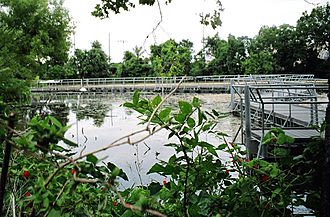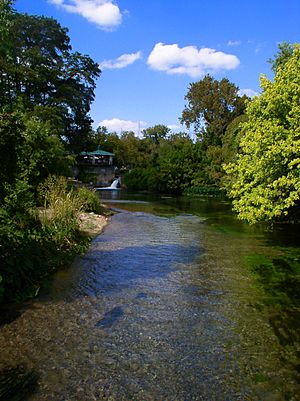San Marcos Springs facts for kids
Quick facts for kids San Marcos Springs |
|
|---|---|

The Wetlands Boardwalk encircles Spring Lake at San Marcos Springs
|
|
| Location | San Marcos, Texas, U.S.A. |
| Coordinates | 29°53′35″N 97°55′53″W / 29.89304°N 97.93128°W |
| Spring source | Edwards Aquifer |
| Elevation | 570 ft (174 m) above sea level |
| Type | Karst spring |
| Provides water for | San Marcos River |
| Magnitude | 1 |
| Discharge | 152 ft³/s (4300 L/s) |
San Marcos Springs is one of the biggest natural groups of springs in Texas. You can find them in the city of San Marcos, Texas. This is about 30 miles (48 km) southwest of Austin. It is also 46 miles (74 km) northeast of San Antonio.
Even though Spring Lake is carefully protected, people can visit it! The Meadows Center for Water and the Environment at Texas State University helps visitors explore. They offer cool glass-bottom boat tours. These tours let you learn about the amazing plants and animals that live there.
How San Marcos Springs Works
The San Marcos Springs are a place where water flows out from the Edwards Aquifer. An aquifer is like a huge underground sponge that holds water. This happens along a special crack in the Earth called the Balcones Fault. More than 200 springs flow from three large cracks and many smaller openings in the rocks.
These springs provide most of the water for the San Marcos River. The river then flows south from where the springs are located.
The springs have always kept flowing. They have never been known to dry up! On average, about 152 cubic feet (4,300 liters) of water flow out every second. The lowest flow ever recorded was in 1956. Even then, 46 cubic feet (1,302 liters) of water still flowed out each second.
In 1849, a man named Edward Burleson built a dam just below the springs. This created a lake called Spring Lake. The lake then covered the springs themselves.
History of the Springs
Scientists who study old things, called archaeologists, think the San Marcos Springs area might be the oldest place in North America where people have lived all the time. They found proof in the ground that people were here about 11,500 years ago. Digging in this spot also uncovered tools and items from Paleo-Indians that are up to 19,000 years old!
The Coahuiltecan people, who are Native Americans, believe these springs are where their people first came from. They called the springs Canocanayesatetlo. This means "warm water." The springs stay at a warm 72 °F (22 °C) all year round.
The first Europeans to see the springs were likely explorers in 1709. Later, a Spanish mission and a settlement were built there. American settlers began moving to the area in 1835. The springs became an important stop on the Chisholm Trail, a famous path for moving cattle.
From 1928 until 1996, there was a fun resort and amusement park called Aquarena Springs at this location. Texas State University bought the land around the springs in 1994. Now, the area is known as The Meadows Center for Water and the Environment.
Amazing Plants and Animals
This region is a special dividing line for where certain plants and animals live. For example, the famous California Fan Palm (Washingtonia filifera) is only found west of the Balcones Fault. This fault line runs right through San Marcos Springs.
San Marcos Springs is home to eight different species that are either threatened or endangered. This means they are at risk of disappearing forever. These special creatures include:
- The Fountain darter (a small fish)
- The Texas blind salamander
- The San Marcos Salamander
- The San Marcos gambusia (another small fish)
- Texas Wild Rice (a plant)
- The Comal Springs Dryopid Beetle
- The Comal Springs Riffle Beetle
- The Peck's Cave Amphipod
To protect these species, there are rules about how much water can be taken from the Edwards Aquifer. This has led to some disagreements in the area.
Scientists and volunteers work at the Texas State University Meadows Center for Water and the Environment. They follow a plan to help the Edwards Aquifer. They remove plants that don't belong there. Then, they plant native species like Texas wild rice. Because of their hard work, the amount of Texas wild rice has grown by 53% since 2015!



